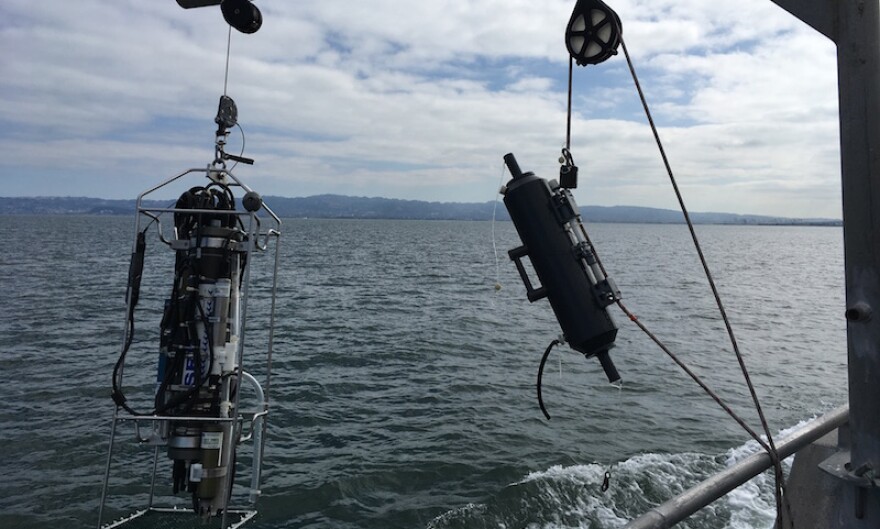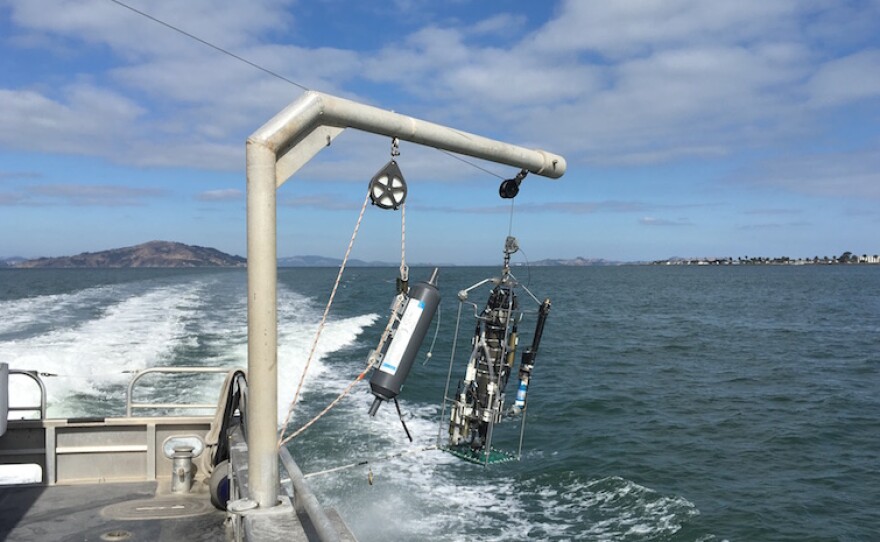Austin Newsom is an Amtrak ticket agent at the Transbay Terminal in downtown San Francisco. On his lunch breaks, he takes walks along the Embarcadero.
“It’s really nice, and people usually, when they’re walking along the waterfront, for whatever reason they have big smiles on their faces. I think it makes people happy.”
Austin started to wonder about what he was looking at, so he reached out to Hey Area, KALW’s reporting project.
“I was curious, what’s the water quality like in the bay, and who is checking it?” he asked.
A common question
Actually, there are people whose jobs are dedicated to answering that question, people like biologist Erica Nejad.
“We get that question all the time" she says. "When we pull into docks, they’re always like ‘How’s it going out there? What’s the water like?’”
When I meet Nejad on this big metal boat, the sun hasn’t come up yet. We put on red life vests and then step into a makeshift lab. Everyone is quickly unpacking test tubes, bottles, and funnels out of boxes before we leave the dock.
Nejad and a team at the U.S. Geological Survey (USGS) go out on this boat twice a month, measuring the water quality up and down the bay. They’ve been doing it for almost 50 years.
“We have this long historical data set, and it’s always the same location,” Nejad says.
On this boat, Nejad and the team measure a variety of things in the water: nutrients like ammonia and phosphate, salinity, temperature and oxygen, and a handful of other parameters.
At sunrise, the boat leaves the dock and motors out of the marina toward our first stop, just underneath the Dumbarton bridge. There, the captain of the boat radios Nejad on a walkie talkie, tells her the location and how deep it is. She jots the info down, and the team starts to take their first samples.
The process
Here’s how they do it: Erica Nejad lowers a large cylindrical metal tube into the water until it hits the bottom of the bay. This is the conductivity, temperature, and depth sensor, or CTD. It’s a pretty common tool in this line of work.

“It’s a really fancy set of sensors, and that little cable connects to it. Erica stands here, and she’ll control it and she’ll be able to see all of the things we’re measuring for, but in real time,” says scientist Zephyr Sylvester, a volunteer on the boat. When Nejad lowers the fancy CTD sensor into the water, Sylvester and another scientist named Charlie Martin also collect water samples at the same spot for comparison, to calibrate the CTD sensors.
Sylvester and Martin take the samples from the bottom of the bay and its surface. They process them in different ways for the different things they’re measuring. First, they pour the water through filters inside the boat’s lab.
“The matter that is floating in the water will stick onto the filter and all the filters have been pre-weighed, so then when they dry out, we can figure how much is actually in the water,” Sylvester says.
Then she hands the water samples -- in brown, light-proof bottles -- to Martin, who pours the water throughother filters.

“So those ones, you can see they’re all taped in black because they filter chlorophyll...and to measure the chlorophyll you don’t want any light to hit it,” Sylvester says.
Other water samples have chemicals added to them and will be analyzed later back at the lab in Menlo Park. All of this takes fewer than 10 minutes. Once they’re done, they move on to the next GPS station and repeat. They reach their last station between Angel Island and Alcatraz around lunchtime.
They’ll analyze all the samples in a lab and enter the data into a public, online database with data collected five or 10 or 40 years before.
“All of those things come together to give us a picture of how healthy the bay is,” Nejad says.
Ok, but, we still haven’t really answered Austin’s question. What’s the water quality like in the bay?
No easy answer
“It’s hard to summarize a take-home answer,” she says.
That’s because there isn’t one. Water quality is a broad term.
“There are so many different parameters that we measure, and half the time we’re out here, we’re very focused on making sure we have good data,” Sylvester adds.
There isn’t one single thing you can measure that tells you if it’s good or bad, overall. County agencies monitor drinking water and other groups look at swimming conditions. The data collected by the USGS team tells us a lot of about phytoplankton. Now, these scientists know that phytoplankton isn't the most charming of marine life.
“If you tell people you’re a marine biologist, they think you study whales and dolphins, and so when you say phytoplankton they just kind of dull down and are like ‘aw….not that type of marine biologist,’” Nejad says.
Phytoplankton, which are basically microscopic marine plants, are food for a wide range of creatures, from whales to snails to shrimp, which is why they’re the perfect thing to measure.
“Without a good healthy phytoplankton community, the rest of the food chain would suffer,” Nejad says.
Too many phytoplankton can be a bad thing, however. They’ll cause algal blooms, which can poison fish, seals, birds, and even people. The San Francisco Bay hasn’t had a big bloom yet, but everyone I talked to says it could happen soon. Nothing in the bay is constant. Just ask Jim Cloern, the leader of the USGS water quality team.
“The San Francisco Bay is a place that is in a continual state of change, and the bay is a very different place now than it was 40 years ago,” Cloern says.
Let’s start with the good news.
“Since the 1950s, we've cleaned up sewage that's been discharged into the bay,” Cloern says, in addition to heavy metals like silver, nickel, zinc from electronics and other industries. The South Bay was one of the most contaminated estuaries in the world.
“[These metals] were so high in the lower part of the South Bay that clams couldn't reproduce,” says Cloern.
Years of treatment worked, and the clams are back, but there are things we still need to work on. The freshwater rivers that feed the bay aren’t flowing at their full capacity. They’re being diverted for agriculture and our lawns and showers. This is essentially creating a drought for the creatures that live in the bay. Another problem is that some fish in the Bay are still contaminated with dangerous chemicals like mercury and PCBs that travel up the food web. They are legacy pollutants, meaning they’ve been around for a long long time.
“There are large quantities of sediment in the San Francisco Bay that were introduced in the gold mining era,” Cloern says.
Then there are the things that aren’t problems yet, but could become issues for the bay: that toxic algae, or microplastics (plastic found in facial scrubs). Cloern says the only way to understand these potential problems is to keep monitoring.
“I think each measurement that we make tells a different story, and all those stories are the book about San Francisco Bay.”
All the scientists studying the bay add to that book every time they gather data, but most of the time, Cloern says, the public only gets to see the cover.
When I meet Austin Newsom on one of his Embarcadero bayside walks, we sit on a bench staring out at the bay, the cover of Cloern's book. The water is blue and calm. There’s someone kayaking in the distance. Twice a month, Erica Nejad and the USGS team cruise by this bench on their way back from taking samples, heading back to the lab, working towards an answer to Austin’s central question: how’s water quality in the bay doing? The answer may never be simple, but, right now, this is how Nejad sums it up.
“I would say it depends, but it’s better than it used to be.”
This story is a part of Hey Area, KALW's collaborative reporting project. Got a question for Hey Area? Ask it below.








